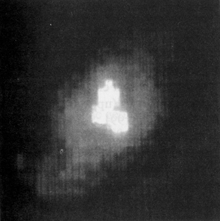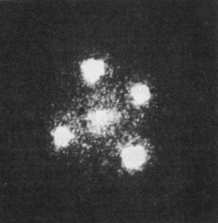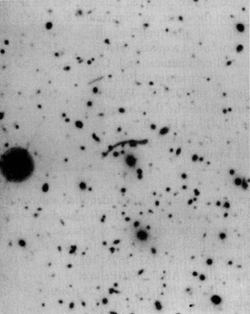 |
Annu. Rev. Astron. Astrophys. 1992. 30:
311-358
Copyright © 1992 by Annual Reviews. All
rights reserved |



A rather different type of lens was first identified independently by
Lynds &
Petrosian (1986)
and Soucail
et al. (1987)
who discovered
a blue, luminous arc ~ 20" long in the rich cluster of galaxies,
Abell 370
(Figure 3). Similar long features
have been reported in
Abell 963
(Lavery & Henry
1988,
Ellis et
al. 1991),
Abell 1352,
1525,
1689,
2163,
2218 (Tyson, personal communication),
Abell 2390
(Pello et
al. 1991),
Cl 0024+17
(Koo 1988),
Cl 0302+17
(Fort 1992),
Cl 0500-24
(Giraud 1988),
Cl 1409+52
(Tyson et
al. 1990),
and Cl 2244-02
(Lynds &
Petrosian 1986) (cf
Table 1).
Detailed theoretical models
(Hammer 1987,
Kovner 1988,
Grossman &
Narayan 1988,
Lynds &
Petrosian 1989)
showed that arcs would
be formed quite naturally by a deep cluster potential well
producing a large tangential magnification in the image of a
background galaxy
(Paczynski 1987a).

| 
|
| Figure 2.The ``Einstein
cross'' gravitational lens
Q2237+031. (Left) Spiral galaxy lens with
redshift z =
0.039. (Right) Four quasar images surrounding the bright
central bulge of the lens obtained using the Faint Object Camera on
Hubble Space Telescope. (Images supplied courtesy C. Blades,
D. Macchetto, and T. Tyson.)
|
The majority of the above clusters, plus about six other clusters in
which long arcs have not yet been reported, exhibit numerous (up to
60) smaller scale arclets
(Tyson et
al. 1990,
Fort 1992,
Smail et
al. 1991,
Soucail 1991).
These are again background galaxies, but
they are much less magnified than the major arcs and are mostly singly
imaged.

|
| Figure 3. Giant arcs formed by the rich cluster of galaxies
Abell 370. The source is a blue galaxy (z =
0.72) located close
to a caustic. Also visible are many smaller arclets, elongated
tangentially with respect to the cluster center. (Image supplied
courtesy B. Fort and G. Soucail.)
|





